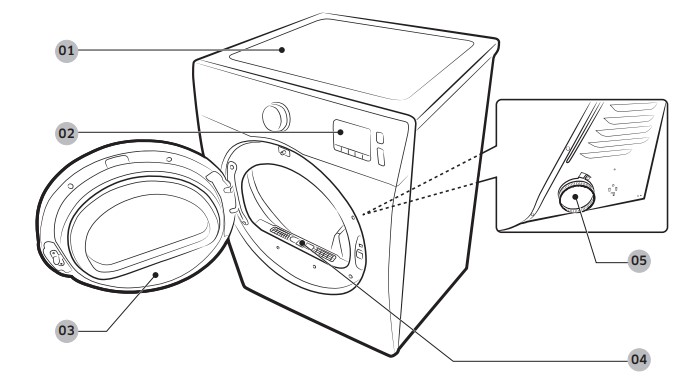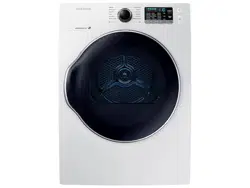Documents: Go to download!
- Owner's manual - (English, French, Spanish)
- Installation
- Operations
- Maintenance
- Troubleshooting
- Specifications
Table of contents
USER MANUAL Dryer
Installation
This dryer must be installed by a qualified technician. The installer is responsible for connecting the dryer to the main power while observing the relevant safety regulations of your area.
What’s included
Make sure all the parts are included in the product package. If you have a problem with the dryer or the accessories, contact a local Samsung service center or the retailer.
Dryer at a glance
01 Top cover
02 Feature panel
03 Door
04 Filter
05 Exhaust duct
Step-by-step installation
Make sure you have a qualified technician install the dryer. Step by step installation instructions start below
STEP 1 Install the exhaust system
- Select a location and move the dryer to the site. For easy access, we recommend you install the dryer in the same location as your washer.
- To change the door direction, see “Switching the door position”
- Install the exhaust system as instructed in the “Exhaust ducting guide” section
NOTE
- To move the dryer easily, lay two of the carton cushions from the packaging on the floor. Tip the dryer on its side so it lies across both cushion-tops. Push the dryer so that it is near its final location, and then set the dryer upright.
- Secure room around the dryer to facilitate ducting and wiring.
STEP 2 Connect the electrical wiring
First, read through the “Electrical requirements” section, and then follow the instructions on this page or the next page. Instructions for a 3-wire system are on this page. Instructions for a 4-wire system are on the next page
For a 3-wire system
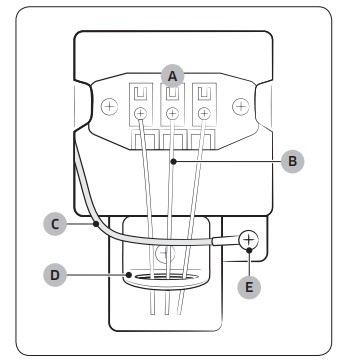 |
A. Center silver-colored terminal block screw B. Neutral wire (white or center wire) C. Neutral grounding wire (white or green/ yellow) D. ¾” (1.9 cm) UL-listed strain relief E. External ground connector |
- Loosen or remove the screws from the center terminal block.
- Connect the neutral wire (white or center wire) of the power cable to the center, silver-colored terminal screw of the terminal block. Tighten the screws.
- Connect the other wires to outer terminal block screws. Tighten the screws
- Tighten the strain relief screws.
- Insert the terminal block cover into the rear panel of the dryer. Then, secure the cover with a hold-down screw.
For a 4-wire system
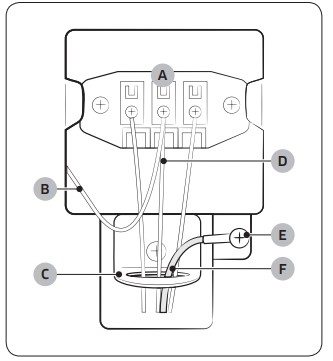 |
A. Center silver-colored terminal block screw B. Neutral grounding wire (white or green/ yellow) C. ¾” (1.9 cm) UL-listed strain relief D. Neutral wire (white or center wire) E. External ground connector F. Green or bare copper wire of power cord |
- Remove the external ground connector’s screw, and connect the ground wire (green or unwrapped) of the power cable to the screw.
- Loosen or remove the screws from the center terminal block.
- Connect the neutral wire (white or center wire) and ground wire (white) to the center, silver-colored terminal screw of the terminal block. Tighten the screw.
- Connect the other wires to the outer terminal block screws. Tighten the screws.
- Tighten the strain relief screws.
- Insert the tab of the terminal block cover into the rear panel of the dryer. Then, secure the cover with a holddown screw.
STEP 3 Level the dryer
To ensure optimal performance, the dryer must be level.
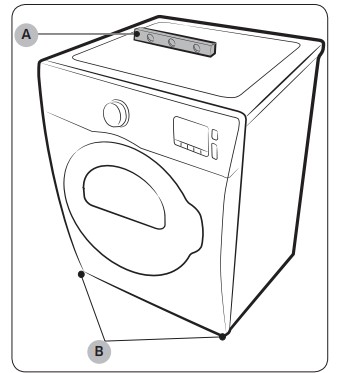 |
|
STEP 4 Final Check
When installation is complete, confirm that:
- The dryer is plugged into an electrical outlet and grounded properly.
- The exhaust ductwork is connected and the joints are taped.
- You have used rigid or stiff-walled flexible metal duct material, not plastic flexible duct.
- The dryer is level and is sitting firmly on the floor.
- The dryer starts, runs, heats, and shuts off properly.
Exhaust ducting guide
Ducting
- Make sure the dryer is installed properly so the air exhausts freely.
- Use 4-inch rigid metal ducts. Tape all joints including the dryer connection. Never use lint-trapping screws.
- To facilitate the exhaust, keep the ducts as straight as possible.
Cleaning
- Clean all old ducts before installing the dryer, and make sure the vent flap opens and closes freely. We recommend that you to clean the exhaust system annually or on a regular basis.
Operations
Feature panel

| 01 Cycle selector | Turn the cycle selector to select a desired cycle. When a cycle is selected, the cycle indicator lights up. |
| 02 Digital graphic display | Displays all cycle information, including the cycle time, information code, operating status, and indicators. |
| 03 Dry Level |
Press to adjust the dryness in the Sensor Dry cycles. The corresponding indicator turns on.
|
| 04 Temp. |
Press to change the temperature of the current cycle.
|
| 05 Time | Press to adjust the drying time for the Manual Dry cycles. This is not available with the Sensor Dry cycles because the dryer determines the drying time by sensing the current moisture level of the load. |
| 06 Wrinkle Prevent | Wrinkle Prevent provides approximately 180 minutes of intermittent tumbling in unheated air at the end of the cycle to reduce wrinkling. Press Wrinkle Prevent to activate this feature. The load is dry and can be removed at any time during the Wrinkle Prevent cycle |
| 07 Mixed Load Bell |
The Mixed Load Bell notifies you when the average dry level in a load is damp dry (80% dried). This lets you take items that you don’t want fully dried or that dry quickly out of the dryer early while letting others continue to dry. You can select this option in all Sensor Dry cycles except for SANITIZE, WOOL, and ACTIVE WEAR. Available dry levels are Normal Dry, More Dry, and Very Dry. |
| 08 My Cycle | Choose your favorite cycle including the cycle time, temperature, and dry level. See “My Cycle  ” for details. ” for details. |
| 09 Adjust Time | You can change the set time in the Manual Dry cycles. To change the cycle time, press Adjust Time until the desired time is displayed. |
| 10 Power | Press to turn on/turn off the dryer. |
| 11 Start/Pause | Press to start or stop operation. |
Simple steps to start
- Press Power to turn on the dryer.
- Turn the Cycle Selector to select a cycle.
- Change the cycle settings (Dry Level, Temp., and Time) as necessary.
- Optionally, you can activate options available by pressing the relevant button (Adjust Time, Wrinkle Prevent and/or Mixed Load Bell).
- Press Start/Pause. The dryer indicator turns on with an estimated cycle time on the display
To change the cycle during operation
- Press Start/Pause to stop operation.
- Select a different cycle.
- Press Start/Pause again to start the new cycle.
Special features
Child Lock
- Child Lock prevents children from playing with the dryer. When Child Lock is activated, all buttons except for the Power button are disabled.
- To activate/deactivate Child Lock, simultaneously press and hold Time and Wrinkle Prevent for 3 seconds.
Drum Light
- To turn on the drum light while the dryer is running, press and hold Dry Level for 3 seconds.
Sound On/Off
- To turn off the dryer’s notification beeps and melodies, press and hold Temp. for 3 seconds.
- To unmute the dryer, press and hold Temp. again for 3 seconds.
My Cycle
You can create your own cycle that contains your preferred settings and use it at your convenience.
- Turn the Cycle Selector to select a cycle. The cycle indicator turns on.
- Set or change the settings (Dry Level, Temp., Time, etc) and/or options as necessary. Each corresponding indicator blinks.
- Press and hold My Cycle for 3 seconds. The dryer stores the selected cycle with its settings.
To use My Cycle, press My Cycle.
Smart Care
- If the dryer displays an information code, you can use Smart Care to check the status of the dryer on a smartphone. To use Smart Care, you must have the Samsung Smart Care app installed on your smartphone.
Maintenance
Cleaning
Feature panel
- Clean with a soft, damp cloth. Do not use abrasive substances.
- Do not spray liquid cleaning agents directly on the display of the dryer.
- Some laundry pre-treatment soil and stain removers may damage the feature panel.
- When using liquid cleaning agents, apply them to the cleaning cloth. Do not apply them directly to the dryer. Wipe up any spills or overspray immediately.
Tumbler
- Remove any stains from the tumbler with an all-purpose cleaner.
- Tumble old towels or rags to remove any remaining stains or cleaning substances. Stains may still be visible, but will not affect subsequent loads
Stainless steel tumbler
- To clean the stainless steel tumbler, use a damp cloth with a mild, non-abrasive cleaner suitable for easily marred surfaces. Remove cleaner residue and dry with a clean cloth.
Dryer exterior
- Clean with a soft, damp cloth. Do not use abrasive substances.
- Protect the surface from sharp objects.
- Do not place any heavy or sharp objects or a detergent container on the dryer. They can scratch or damage the top cover of the dryer.
- The dryer has a high-gloss finish on the entire surface. Be careful not to scratch or damage the surface.
Exhaust system
- Check and clean the exhaust system on a yearly or regular basis to maintain optimum performance.
- The external exhaust hood must be cleaned more frequently to ensure proper air flow.
Troubleshooting
Checkpoints
If the dryer operates abnormally, first check the list of problems in the table below and try the suggested actions.
Does not run.
- Make sure the door is latched shut.
- Make sure the power cord is plugged into a live electrical outlet.
- Check your home’s circuit breakers or fuses.
- Press or tap Start/Pause (Hold to Start) again if the door is opened during a cycle.
- Clean the lint filter.
Does not heat.
- Check your home’s circuit breakers or fuses.
- Some cycles do not require heating. Check the selected cycle again.
- For a gas dryer, make sure the gas supply is on.
- Clean the lint filter and exhaust duct.
- The dryer may have moved into the cool-down phase of the cycle.
- Turn off the Eco Dry option for the NORMAL or TIME DRY cycles. When the Eco Dry option is on, the dryer performs an air dry process in the beginning of the cycle to reduce energy consumption. The air dry process does not use heated air, so you may feel that the dryer is not being heated, but this is normal.
Does not dry.
- Check all of the above, plus...
- Make sure the exhaust hood outside your home can open and close freely.
- Check the exhaust system for lint buildup. Ducting should be inspected and cleaned annually.
- Use a 4” rigid metal exhaust duct.
- Do not overload. 1 wash load = 1 dryer load.
- Dry heavy items and light weight items separately.
- Large, bulky items, such as blankets or comforters, may require repositioning to ensure even drying.
- Make sure that your washer is draining properly and extracting adequate water from the load.
- The load may be too small to tumble properly. Add a few towels and restart the dryer.
- The load may be too large to tumble properly. Remove some items and restart the dryer.
- Clean the lint filter.
Is noisy.
- Check the load for objects such as coins, loose buttons, nails, etc. Remove promptly.
- It is normal to hear the dryer gas valve or heating element cycle on and off during the drying cycle.
- Make sure the dryer is leveled properly as outlined in the installation instructions.
- It is normal for the dryer to hum due to the high velocity of air moving through the dryer drum, fan, or exhaust system.
Dries unevenly.
- Seams, pockets, and other similarly heavy areas may not be completely dry when the rest of the load has reached the selected dryness level. This is normal. You can choose a higher dryness level or a cycle that involves a higher dryness level.
- If one heavy item is dried with a light weight load, such as one towel with sheets, it is possible that the heavy item will not be completely dry when the rest of the load has reached the selected dryness level.
- For the best drying results, dry heavy items and light weight items separately.
Has odors.
- Household odors from paint, varnish, strong cleaners, etc. may enter the dryer with the surrounding room air. This is normal as the dryer draws the air from the room, heats it, pulls it through the tumbler, and exhausts it outside.
- When these odors linger in the air, completely ventilate the room before using the dryer.
- If odors persist, wash and dry the items again.
Lint on clothes.
- Make sure the lint filter is cleaned before every load. For clothes that naturally build up lint, clean the filter during the cycle.
- Some fabrics are lint producers (for example, a fuzzy white cotton towel) and they must be dried separately from clothes that are lint trappers (for example, a pair of black linen pants).
- Divide larger loads into smaller loads for drying.
- Check pockets thoroughly before drying, then dry clothes.
- Remove lint inside the drum before drying.
Items still wrinkled after WRINKLE RELEASE.
- Small loads of 1 to 4 items work best.
- Load fewer items. Load similar-type items.
Extended time.
- Sensor Dry automatically senses the moisture in the load and shuts the dryer off when the selected dryness level is reached. The drying time can change according to the type and amount of laundry. See the cycle chart for reference.
If a problem persists, contact a local Samsung service center.
Information codes
If the dryer fails to operate, you may see an information code on the display panel. To determine what you should do, check the list of codes in the table below, and then try the suggested actions.
| Code | Action |
|---|---|
| dC |
Operating the dryer with the door open.
|
| FC |
Invalid power source frequency
|
| AC |
Electronic control problem (Invalid Communication).
|
| HC |
Invalid heating temperature when dryer is running.
|
| 9C1 |
The electronic control needs to be checked.
|
| tC |
The thermistor resistance is very low or high.
|
| bC2 |
Invalid state of a button.
|
| dF |
Incorrect door switch.
|
If any information code keeps appearing on the screen, contact a Samsung service center.
Specifications
Fabric care chart
The following symbols provide garment care direction. The clothing care labels include symbols for drying, bleaching, ironing, and dry cleaning. The use of symbols ensures consistency among garment manufacturers of domestic and imported items. Follow care label directions to optimize garment life and reduce laundering problems.
Wash cycle
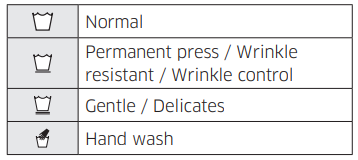
Water temperature

 NOTE
NOTE
The Water Temperature table lists appropriate wash water temperatures for various items. The temperature range is 106-126 °F (41-52 °C) for Hot, 84-106 °F (29-41 °C) for Warm, and 61-84 °F (16- 29 °C) for Cold. (Wash water temperature must be a minimum of 61 °F (16 °C) for detergent activation and effective cleaning.)
Bleach
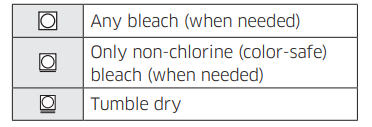
Normal

Special instructions

Heat setting
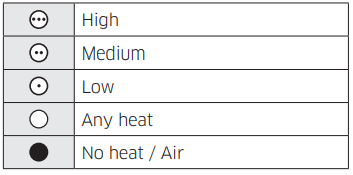
Iron dry or steam temperatures

Warning symbols for laundering
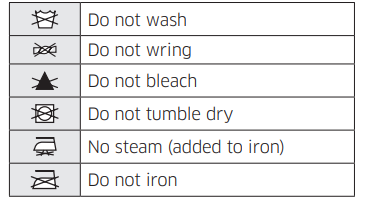
Dry-clean
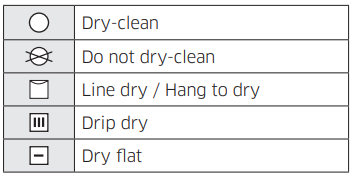
Protecting the environment
- This appliance is manufactured from recyclable materials. If you decide to dispose of this appliance, please observe local waste disposal regulations. Cut off the power cord so that the appliance cannot be connected to a power source. Remove the door so that animals and small children cannot get trapped inside the appliance
Specification sheet

See other models: DV45K6500GW DV42H5000GW NZ30K7880US S9 MG11H2020CT
